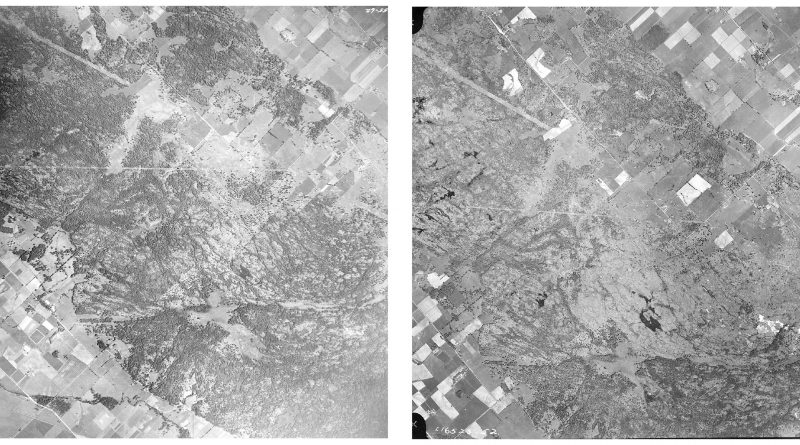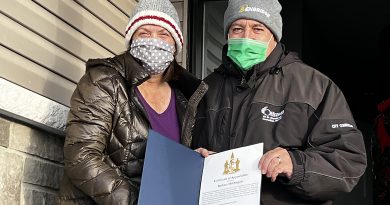Fire on the ridge: A history of forest fires in Carp
The following story reprinted in West Carleton Online is with permission from the original publisher the Friends of the Carp Hills (FCH) and the author FCH board member Anne Wong:
With a Masters in Library Science, FCH Board member Anne Wong had the skills and experience to research information about the two large fires in 1955 and 1870 that have swept our area in recorded history. For her article she visited the National Air Photo Library and used the Huntley Township Historical Society’s resources at the Carp Library. She also interviewed William (Bill) Bell, Ottawa Fire Service, Sector Chief, District 6 about current wild land fire management, which is particularly relevant for area residents who live near brush that becomes tinder dry during drought conditions like those in 2012 and 2016.
The Carp Bush Fire of 1955
The Carp Hills extend from March Road to Kinburn Side Road and are bounded by Marchurst Road and Carp Road. The landscape is currently forested and sprinkled with marshes, bogs, fens, and ponds – a verdant wetland. But it is not an old forest.
The Carp Bush Fire of 1955 began in Kinburn. The Ottawa Journal of Monday, July 25, 1955 reported lightning struck a tree on the farm of H E Cary, near Kinburn. It smouldered for about a week before bursting into flames on Friday, July 22, 1955.
By Monday, July 22 approximately 1,500 acres had burned. The fire burned so brightly that red flashes could be seen at the Britannia Yacht Club. Smoke over the Village of Carp was said to be visible up to 10 miles distant.
Bulldozers, brought in from Arnprior by Sam Bond, were used to create trenches, however the fire succeeded in jumping these and continued its destructive path, aided by the wind. Farmers and volunteers from the area fought the fire using axes, shovels, beating the flames with brush, and hosing the flames with hand-operated stirrup pumps. Water was delivered by trucks to the pumps at the base camp created at Holland Garage – located north of Carp on the exhibition ground road.
The fire frontage was five miles wide and burned through the forest in Huntley, but also in March, Fitzroy, and Torbolton Townships The wives of the firefighters and the women of Carp were intrinsic to the effort – providing food and beverages. Young men were actively involved in the fire-fighting effort
The fire destroyed valuable timber, estimated by one logger at the time to be worth $375,000. “An average acre of pine was worth $250.” [The Ottawa Journal]
This, however, was not the first fire to ravage the Carp Hills. Nor was it the most devastating.
The Great Fire of 1870
On Aug. 14, 1870 the Ottawa Citizen wrote about severe drought – “the consecutive rainless days was something unparalleled in the history of the country”.
Rain had not fallen in the Ottawa Valley for several months. The Great Fire of the Ottawa Valley began Aug. 17, 1870. Accounts vary as to the cause of the fire. The Carleton Saga suggested, “There seemed to be no definite origin to the fire, or rather series of fires, that spiraled from such widely separated source.”
Another newspaper report indicated it started as a controlled burning of brush by a railway crew. High winds from the southwest blew flames into the tinder dry forest near Pakenham. Wind speeds increased to gale force and the fire spread quickly through spruce and pine trees on the limestone ridges; engulfing Lanark, Fitzroy, Torbolton, March, and Huntley Townships.
It was erratic; burning through and along cedar fences, skipping over areas and fields, yet burning through wide swathes of forest and fields. The unpredictability of the fire burnt farmhouses, barns, and outbuildings; but left other buildings nearby intact. Travelling at 10 miles per hour, at one point the fire stretched from Almonte to the Ottawa River, thoroughly engulfing the Carp Ridge, but oddly sparing the Village of Carp.
A first person account given by Christie Graham, recorded by John Graupner in 1945, tells of how the Graham family loaded a hay wagon with their belongings and drove it in to the Ottawa River.
“The Great Fire of 1870 flattened much of western Carleton County in that one day in August.” [Curry, Terrence M.] The valuable timber that once covered Huntley Township was completely obliterated. [ H Belden & Co]
The forest coverage that exists today on the Carp Ridge is a mixture of oak, beech, maple, ash, ironwood, bitternut, fir, and pine. There are cedar stumps, gently decaying that are remnants of the former coverage.
Current wildland fire management
In any woodland area, fire prevention is the preferred way to prevent a catastrophic event. The Ottawa Fire Services (OFS) has an active program of public education, part of the Fire Smart Program – firesmartcanada.ca.
Should a fire develop in rural Ottawa, the OFS have been trained in the best methods of suppression. In conjunction with the Canadian Wildland Fire Strategy; Ottawa’s firefighters have the training, equipment and certification to tackle a woodland fire. Additionally, in 2014, OFS received accredited agency status with the Commission on Fire Accreditation International (CFAI), becoming one of only six accredited agencies in Canada.
“Accreditation is an international recognition of achievement. It shows to your community that your agency is performing to industry best practices and is holding itself accountable through an external peer review…. Accreditation is valid for five years.” https://cpse.org/accreditation/faqs/
The initial call for a wildland fire will dispatch a pump truck, tank truck, brush truck and the sector chief. The first officer on the scene of a fire assesses the wind speed, property at risk, people in the area and the possibility of missing people. Depending on the evaluation, additional resources will be requested.
Ottawa fire atations are equipped with pumper trucks, tankers, ladder trucks, rescue trucks, boats, brush trucks, gas powered floating pumps, and ATVs; distributed throughout the urban and rural area. Each of the 12 rural stations provides a specialty, with five of the stations having special brush trucks to combat brush and grass fires. Brush Truck 63, acquired in 2019, is located in Constance Bay and is a key piece of equipment for tackling grass and wildland fires. Every Pump truck is outfitted with a forestry pack including 400’ of forestry hose capable of being attached to additional hoses to extend the reach. On the ground tools include flails, chain saws, axes and shovels – the same implements that would have been in use in 1955 and 1870 (except the saw would have been manual).
What is definitely new in the arsenal is the use of drones to assist in firefighting. Drones, using high definition cameras and infrared, fires (and people) can be located in remoter areas. With high resolution cameras, the type, size and location of a fire can be determined.
The personnel who could be called upon to fight include more than 900 urban firefighters and just under 500 volunteer firefighters in the rural areas. The volunteer fighters have the same training as the career fighters and all are National Fire Prevention Association (NFPA) certified.
In a worst-case scenario, the Ministry of Natural Resources has water bombers stationed in Thunder Bay with satellite landing areas throughout the province.
And it may seem madness to have a burn ban in the spring, there is method behind the decree:
While the ground may be soggy from the winter snow melt, the tips of the grass are dry. When they catch fire, it rolls across the top of the ground – spreading rapidly
Additionally, the wet and soaked ground limits access for fire fighting vehicles. Just sayin’.
Information for this article was sourced from the following
A brief account of the late conflagration near Ottawa August 17, 1870: Copied from the Ottawa and other papers : A collection of newspaper articles written at the time of the fire describing it in Huntley Township and the Ottawa area; Huntley Township Historical Society. September 1992
Carleton Saga; Walker, Harry & Olive. 1968.
Gallant Grahams of Canada; Graupner, John.
Illustrated Historical Atlas of Carleton County, Ontario; H Belden & Co. 1879. (Facsimile edition printed 1971).
National Air Photo Library.
Ottawa Free Press; 25 August 1870.
Ottawa Journal; Monday, 25 July 1955.
Ottawa Valley’s Great Fire of 1870: The 19th Century Press and the Realty of a Great Disaster; Curry, Terrence M. 2009.
Thank you to William (Bill) Bell, Ottawa Fire Service, Sector Chief, District 6 for the information about the Ottawa Fire Service and to the reference librarians at the Ottawa Public Library for their assistance.
The Friends of the Carp Hills
The Friends of the Carp Hills is a volunteer-run, non-profit organization dedicated to preserving the Carp Hills for the benefit of nature and the community in perpetuity. The group works collaboratively with landowners, the City of Ottawa, government agencies, businesses, and community groups to preserve areas of wilderness for conservation and public access in the Carp Hills. Find out more at: carphills.com.












Pingback:Carp Fair president talks tough decision – West Carleton Online
Pingback:WCDR’s proactive response to potential disasters – West Carleton Online
Pingback:Musician marks Great Fire anniversary – West Carleton Online
Pingback:Davies: WC faces week of challenging memories – West Carleton Online
Pingback:Family photo fundraiser hit for Carp Fair – West Carleton Online